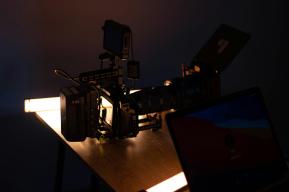Idea
A deep dive into the transatlantic slave trade

Madick Gueye
Doctor of underwater archaeology, coordinator of the Slave Wrecks Project, Cultural Engineering and Anthropology Research Unit (URICA) at IFAN, Cheikh Anta Diop University, Dakar (Senegal).
Today known as a place of memory dedicated to the slave trade, the island of Gorée was the largest slave-trading centre on the African coast from the 15th to the 19th century. Thousands of human beings passed through this small island some five kilometres from Dakar, Senegal, before being used as forced labour in American plantations.
It is estimated that nearly a thousand slave ships wrecked between Africa and the Americas. Only a tiny fraction of these wrecks are known and documented today. Consequently, a huge amount of mapping work needs to be undertaken. Tracking down these archeological remains and exploring the underwater sites would help obtain invaluable scientific data and shed light on the tragic history of the triangular trade.
The waters surrounding the island of Gorée, inscribed on the World Heritage list in 1978, are an important part of this history. This is why, in 2016 and 2017, a team of research divers from the Institut fondamental d'Afrique noire (IFAN) at Cheikh Anta Diop University in Dakar, undertook two underwater archaeological research missions off the coast of the island. Using a magnetometer to detect the presence of metals, combined with a navigation system and a depth sounder, we were able to cover the entire coastline of the island within a radius of 500 metres, recording the data generated with the aid of software. The subsequent work of cataloguing enabled us to identify 24 archaeological sites, confirming the richness of Senegal's underwater cultural heritage.
The Middle Passage
The team then carried out dives in some of the sites. We had a clear mission – to assess the potential of the sites, measure their extent, map the apparent structures and study their environment. This was a decisive factor in the conservation of the remains. So far, IFAN has identified two major sites: HMS Sénégal, which was shipwrecked in 1780, and a second site dating from the early 19th century that requires more in-depth archaeological assessment before it can be fully identified.
In Senegal the research focuses on the Middle Passage, the transatlantic stage of the triangular trade linking Europe, Africa and the Americas, a field that still remains largely undocumented. Given its strategic position and major role in transatlantic trade relations, Senegambia – historically a geographical area corresponding to the Senegal and Gambia river basins – appears to be a privileged area to be explored.
The Senegalese waters are home to many slave shipwreck sites
For over four centuries, thousands of European slave ships sailed along the coast of West Africa, with the main trading points centred on the coastal regions of Saint-Louis, Gorée, Rufisque, Portudal, Joal, Albreda and Rivières du Sud.
Obstacles to navigation, such as poor visibility and sandbanks, as well as rivalry between European powers, caused many of these vessels to run aground. Reconstructing what life was like on board and the hardship endured by these men and women is one of the aims of our research.
Training at sea and in the classroom
These initial explorations were carried out as part of the Slave Wrecks Project, initiated by the Smithsonian Institution's National Museum of African American History and Culture in Washington, DC (United States). The aim of the international network of researchers set up by the project is not only to document the history of the transatlantic slave trade, but also to approach it in a new way by placing people at the heart of the story.
Training is an essential dimension of this initiative bringing together Africans and African-American descendants to study underwater archaeology, both at sea and in classrooms. Since 2014, the Slade Wrecks Project has been able to train a network of researchers at IFAN's Archaeology Laboratory in diving and marine archaeology techniques and technology. It has thus been instrumental in setting up the first African-led marine archaeology team in West Africa.
The Cheikh Anta Diop University has established the first African-led marine archaeology team in West Africa
Underwater archaeological sites enable us to re-examine the stories and legacies of the slave trade. By promoting knowledge, the underwater archaeology of the slave trade fosters reconciliation and promotes social justice.
The desire to document slave trade history by studying underwater remains is not something new. Since the late 1980s, researchers such as Max Guérout, a French underwater archaeologist, have been working on the subject. He led two diving missions to the Gorée area in 1988, as part of UNESCO's programme to safeguard the island. The work of Professor Ibrahima Thiaw, a Senegalese archaeologist and specialist in the living conditions of the slaves on Gorée, has also been instrumental in the development of this discipline in Senegal.
A very present past
The transatlantic slave trade is not only a thing of the past – Senegalese social landscapes are still strongly marked by the stigma of slavery. Racial stereotypes arising from the slave trade have had a profound impact on intercultural and interracial relations.
The question of the role played by the African continent in the export of black slaves continues to be debated. This topic, sometimes reduced to simplistic statements, has been the source of misunderstandings and even tensions with Afro-descendant Americans. Africans were undeniably implicated, but the moral and political economy of the slave trade is highly complex and cannot be reduced to clichés or hasty interpretations.
In this context, a better understanding of the past and of the complexity of the transatlantic slave trade is essential to foster dialogue and heal the wounds of the past, wounds which are sometimes still open. Moreover, by involving the local population in the research we will help them take ownership of the black slave trade history.
Provided, however, that the ruins and remains can continue to reveal their secrets to future generations. In fact, underwater archaeological sites face a number of threats. Several dozen metres below the surface, micro-organisms, marine fauna and the mechanical effects of the sea, currents and even fishing gear can destroy wrecks.
Buried in the sediment, sheltered from light and in an oxygen-poor environment, organic matter is well preserved. But once brought to the surface, the objects are fragile and need to be preserved with appropriate conservation treatment. This is particularly true of iron objects and wood. Indeed, the archaeological objects excavated by Max Guérout in the late 1980s are already deteriorating.
Senegal does not yet have a conservation laboratory, which is essential for continuing underwater archaeological excavations
Senegal does not yet have a conservation laboratory, an essential element for continuing underwater archaeological excavations. The creation of such an establishment is therefore imperative for the future of our research and, more broadly, for the documentation of the history of the transatlantic slave trade.






